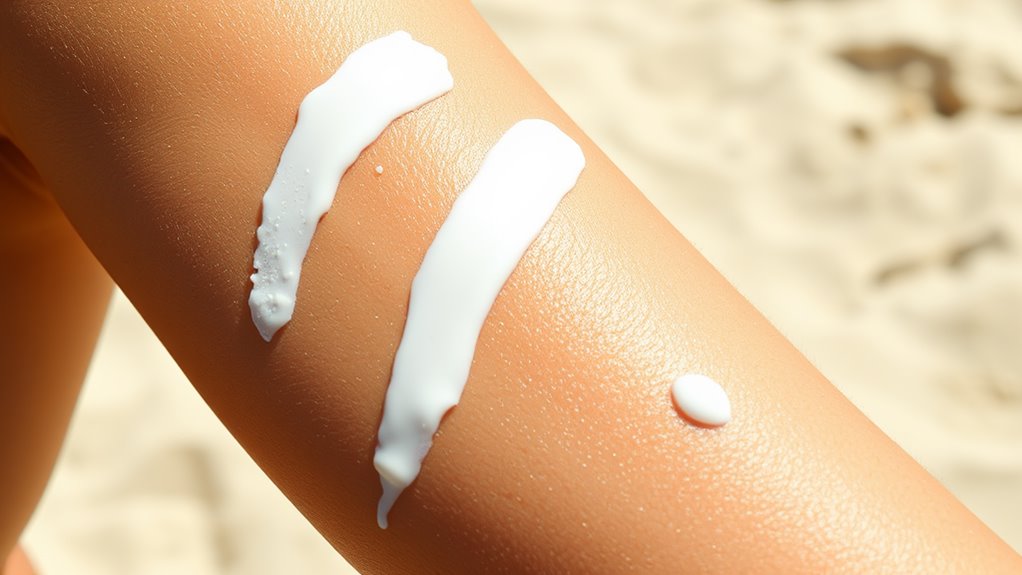You’re Using Sunscreen-But Are You Applying It Right.
You’re using sunscreen, but are you applying it right? Start by choosing a broad-spectrum SPF 30 or higher that matches your skin type, like mineral options for sensitivities. Use about one ounce for your body, rubbing it evenly on your face, neck, ears, and exposed skin 15-30 minutes before sun exposure. Reapply every two hours, especially after swimming or sweating, and avoid missed spots or expired products. Master these habits for better protection, and uncover more strategies to keep your skin safe.
Key Takeaways
- Apply a nickel-sized amount of sunscreen to your face and neck, rubbing in circular motions for even coverage.
- Use sunscreen 15-30 minutes before sun exposure to allow it to absorb and form a protective barrier.
- Reapply every two hours, especially after swimming or sweating, to maintain protection.
- Cover all areas, including ears, eyelids, hands, and feet, to prevent missed spots.
- Choose a broad-spectrum SPF 30 or higher sunscreen suited to your skin type for optimal results.
Choosing the Right Sunscreen Type
When choosing the right sunscreen type, you’ll first need to evaluate your skin’s needs and the sun’s risks.
Consider your skin type: if it’s oily, pick a non-comedogenic, gel-based formula; for dry skin, choose a moisturizing lotion.
Sun protection tips emphasize broad-spectrum options that shield against both UVA and UVB rays to prevent aging and burns.
Opt for mineral sunscreens with zinc oxide or titanium dioxide if you have sensitivities, as they sit on the skin’s surface without absorption.
For active lifestyles, select water-resistant varieties to maintain defense during sweat or swims.
Always verify labels for ingredients that suit your routine, ensuring effective barriers against environmental damage while prioritizing safety and efficacy in your daily regimen.
Determining the Proper Amount to Apply
Applying the right amount of sunscreen ensures you get the protection you need without wasting product. You’ll want to follow expert guidelines to avoid underapplication, which can leave you vulnerable to UV damage.
The American Academy of Dermatology suggests using about one ounce—roughly a shot glass full—for your entire body when exposing large areas like during beach outings. For your face and neck, aim for a nickel-sized amount to cover evenly without excess.
Remember, factors like skin type and activity level influence this; fair skin or intense sun exposure might require slight adjustments, but don’t go overboard.
Always check the product’s SPF claims depend on proper usage, so measure accurately to maximize benefits and minimize waste. This precise approach keeps you safe and efficient.
Step-by-Step Application Techniques
With the right amount of sunscreen ready, you’ll apply it effectively by following these key techniques.
First, rub a nickel-sized dollop onto your face and neck, using your fingertips to spread evenly in circular motions for full coverage.
Don’t forget high-risk areas like ears, eyelids, and hairline—gently pat product around eyes to avoid irritation.
For your body, squeeze lotion into your hands and massage it onto exposed skin, such as arms, legs, and chest, ensuring no streaks or missed spots.
Use long, smooth strokes on larger areas for uniform absorption.
Always cover the backs of hands and tops of feet, as these burn easily.
Timing Your Sunscreen Application
Timing your sunscreen application correctly maximizes its protection against UV rays.
You’ll want to apply it 15 to 30 minutes before heading outdoors, allowing the formula to absorb into your skin and form a protective barrier. This timing ensures that active ingredients, like zinc oxide or avobenzone, bind effectively, shielding you from both UVA and UVB rays that cause burns and aging.
Don’t rush; if you’re swimming or sweating, remember that initial application sets the foundation for defense. Choose a broad-spectrum SPF 30 or higher based on your routine—daily for incidental exposure or higher for prolonged outdoor activities.
To achieve ultimate skin protection, consider pairing this timing with regular reapplication every two hours during extended sun exposure.
Reapplying for Continuous Protection
You need to reapply sunscreen regularly to keep your skin protected from UV rays.
Reapply it every two hours and immediately after swimming or sweating.
This simple habit ensures you’re maintaining effective coverage all day long.
Reapply Every Two Hours
While initial protection from sunscreen fades with exposure, reapplying it every two hours maintains a strong barrier against UV rays.
You must prioritize this routine to sustain effective defense, as UV radiation persists and can penetrate clouds. By reapplying consistently, you’ll reduce risks of burns and cellular damage, ensuring your skin stays shielded during extended outings.
- Set a phone timer for every two hours to stay on track.
- Use the full recommended amount each time for full coverage.
- Reapply after activities that might rub off sunscreen, like sports.
- Opt for water-resistant formulas if needed, but still follow the schedule.
- Monitor the clock closely to avoid gaps in protection.
After Water Exposure
When you emerge from the water, reapply your sunscreen immediately to restore its protective barrier against UV rays. Even water-resistant formulas lose effectiveness after swimming or sweating, so don’t wait—UV exposure continues unabated.
You’ll need to use a broad-spectrum SPF of at least 30, applying a generous amount to all exposed skin. First, towel dry gently to avoid rubbing off residue, then cover every area, including ears, neck, and feet. This ensures continuous protection, reducing your risk of sunburn and long-term skin damage.
Remember, reapplication isn’t optional; it’s essential for activities like beach outings or pool days. By staying vigilant, you’re actively safeguarding your skin’s health against harmful UVA and UVB rays.
If you’re using spray or stick sunscreens, rub them in thoroughly for even coverage. Always check the product label for specific reapplication guidelines to maximize efficacy.
Adapting Application for Various Body Parts
Adapting sunscreen application to various body parts maximizes protection and comfort. You must tailor your technique to each area’s unique needs, ensuring thorough coverage without irritation. This approach helps prevent burns on exposed skin while accommodating different textures and sensitivities.
-
Face: Choose a lightweight, non-comedogenic formula; apply gently with fingertips to avoid eye contact.
-
Scalp: Part your hair and dab lotion directly on exposed areas, or use a spray for even distribution.
-
Ears and neck: Cover the tops, lobes, and back of your neck with a thin layer, using your fingers for precision.
-
Arms and legs: Rub in generously with circular motions to reach all surfaces, including elbows and knees.
-
Hands and feet: Don’t overlook palms, fingers, soles, and toes; reapply after washing or activities.
Avoiding Common Application Errors
Even though you’ve tailored sunscreen application to different body parts, it’s easy to make mistakes that undermine its protection. One key error is using too little—apply at least one ounce for full body coverage to ensure an even barrier.
You might rush and miss spots like ears, scalp, or the back of your neck, leaving vulnerable areas exposed. Another pitfall: forgetting to reapply every two hours, particularly after swimming, sweating, or toweling off, which washes away the product.
Avoid applying it over makeup without proper blending, as this creates gaps in protection. Don’t shake the bottle inadequately; mix it well for uniform consistency.
Lastly, check for expiration dates to prevent using degraded formulas. By correcting these habits, you’ll bolster your sunscreen’s reliability and safeguard your skin effectively.
Enhancing Sunscreen Effectiveness Daily
To maximize sunscreen’s daily impact, you’ll want to integrate smart habits that amplify its protective barrier. Start by selecting a broad-spectrum formula with at least SPF 30, and apply it generously to all exposed areas.
Reapplication throughout the day ensures ongoing defense against UV rays, while pairing sunscreen with other strategies boosts overall efficacy and simplifies your routine.
- Reapply every two hours, or immediately after swimming or sweating, to maintain the barrier.
- Choose water-resistant sunscreens for active days to extend protection.
- Layer with protective clothing, like long sleeves and hats, for added UV defense.
- Seek shade during peak sun hours (10 a.m. to 4 p.m.) to reduce exposure.
- Store sunscreen in a cool, dry place to preserve its active ingredients and effectiveness.

